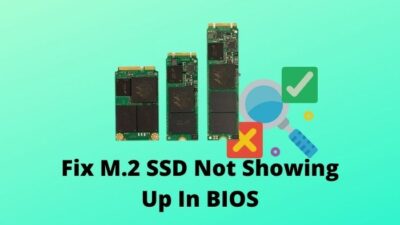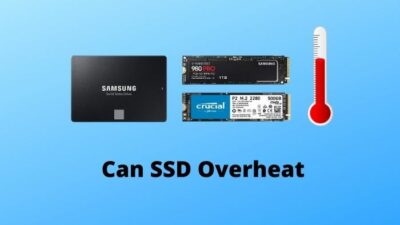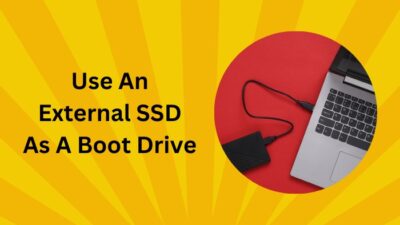“Commercial SSDs made their first entrance into the market in the early 1990s— in 1991, a 20MB SSD sold for $1,000” — Can you believe that?
Being a computer geek when I did know about this piece of information for the first time, I took my time thinking how far we have traveled, how far we will go, maybe there’ll be portable SSDs someday, and whatnot.
Crazy, right?
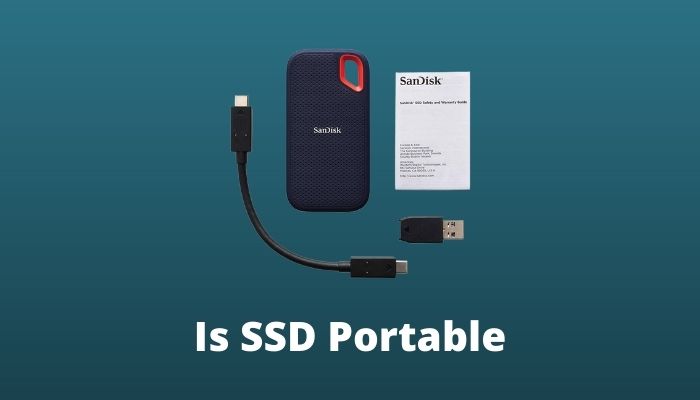
As I have done heavy gaming and video rendering for a long time, I have been using SSDs since some of you weren’t born. So, I must say, I’ve got a pretty knowledge and experience using them.
Do read till the end to know more about both portable and non-portable SSDs, which one to get, which one is worth more, and so forth.
So, here comes the question again. Is SSD portable?
Without further explanation, let’s dive into the matter, shall we?
Is SSD Storage External?
Like external HDD, there are also external SSDs out there. You can connect these external SSDs to the outside of your device, and it’s an easy and portable way to store all of your files. But before going into the external SSD storage, check out what an SSD is.
So, what is an SSD?
An SSD is a flash technology-based storage that does not require additional power to run itself. It is commonly known as a non-volatile flash memory. Being NOR and NAND logic gates, SSDs use NAND logic gates usually. More specifically it uses ‘Not AND’ or ‘Negated AND’ logic gates.
If you travel very frequently or regularly need to move large files, you should get external storage for the movement. External storage comes into two flavors— HDDs and SSDs. Though they do very different things, without any doubt, SDDs are way faster than HDDs. We will discuss deciding which one to use on the following topic.

So, as you already know about portable SSDs, what do you think? Would you buy it?
Or would you switch it to your internal or external HDD?
Portable SSD vs. Portable HDD—Which External Drive you should Use?
This is one of the most FAQs over the internet. Today, for the first and last time, I believe you can decide which one to use for yourself.
But before going forward, I have to make sure you are familiar with portable SSDs.
What is a portable SSD?
A portable SSD is almost the same as an internal one without the casing and cable. If you think of portable SSD as a better version of SSD, you are living in a fool’s paradise. We need portable SSDs for many reasons, like heavy gaming, video rendering, etc.
Check out our latest post to Enable Aura Sync Control for Corsair RGB Memory.
SSDs and HDDs are two very different pieces of hardware. In HDDs, a series of disks coated in a magnetic material is rotated at high speed, while the read or write arm follows commands to read or write information. Reading and writing occur by changing the magnetic pattern on the platter’s surface, where one magnetic polarity correlates to 0 and the other to 1. Thus, the disk can read and write.
In SDDs, there are no mechanical parts like HDDs, and data is stored and retrieved using only electronic circuits. As I said earlier, generally, SSDs use non-volatile flash memory; if you turn off your PC, the device will retain data while others will have volatile memory, use batteries to maintain power, and retain their data.
Here, in SSDs, the data is electronically programmed into the storage cell rather than creating a magnetic pattern like in HDDs. Some of the cells are organized into pages and 64 pages are groped into a block.
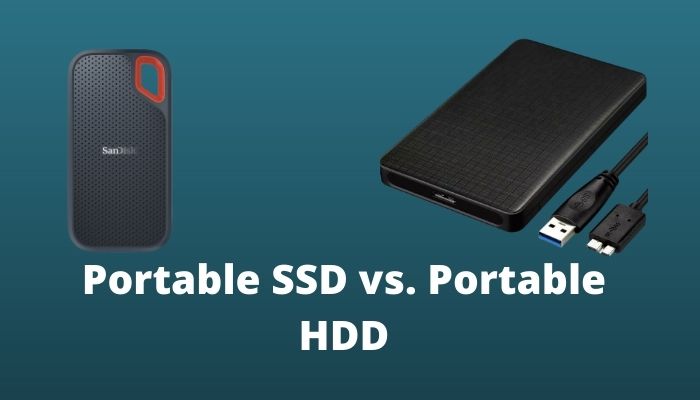
These blocks can only be written into once totally. I repeat these blocks we are talking about can be written into only once. They have to be erased entirely and re-written for performing another task. If you erase and rewrite data to the same block over and over again, the drive will wear out far faster than its actual lifespan.
Check out our expert’s recommended best Corsair RAM.
So, what happens is, rather than writing over in the old place, new data is written to a new block. It would be a more extended period before the free space is erased and replaced with the latest data.
The biggest external hard drives you think aren’t always the best drives you should buy. There are many options regarding the connection between your external device and your PC or laptop, and it depends on your demand only.
SSDs boot up faster, load and save files quickly, work with big files swiftly, and operate in more extreme temperatures and altitudes. But to be honest, SSDs reliability varies from brand to brand, model to model, and are not recommended for archival use. Also, It is more expensive than traditional drives.
On the other hand, HDDs are reliable over a long period, cheaper than SSDs, best for archiving and storing files, easier to erase and reuse reliably. But HDDs are insanely slower than SSDs in terms of responding, weak to vibration and shock, heavier, can be in a state of mechanical failures.
I was in this very place of yours, and I was a bit confused too. So, I used both of them and satisfied my need. Now it’s up to you to decide whether to use an HDD or SSD.
What your actual need is the determiner of switching from HDD to SSD, vice versa. But don’t blame me if you buy both!
The top-end diffusion that the LEDs offer is world-class. Check out some of the best 2666 MHz RAMs for a faster gaming experience.
Internal SSD Vs. Portable SSD
In the 21st century, we have to store massive amounts of data and work the best out of it, which sometimes slows down our systems. So, here comes internal and portable SSDs as a solution, a versatile one. They are faster than HDD in terms of working with data and transferring them, more durable, and a whole lot more.
You can think as they are both SSDs, they value the same. If you are one of them, you are mistaken. There are quite a few differences between internal and portable SSDs. But there are no separate ways for both of them to read or write data. The main difference lies in their connection to computers.
The internal SSDs connect via SATA or m.2, and the portable ones connect through USB or eSATA.
These days, SSDs run at about 500Mbps speed, while the internal SATA interface transfers data at a rate of 6Gbps. So, you have to make sure to connect it to an interface not less than a 500Mbps transfer rate. Otherwise, you won’t be able to get the drive’s maximum speed.
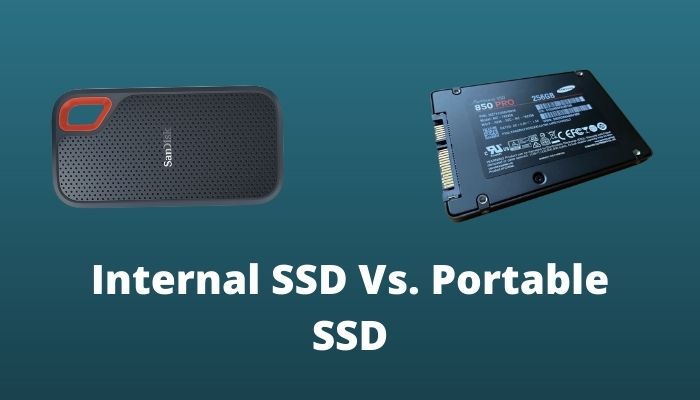
If you buy both portable and internal SSDs with the same transfer rate, the portable will always experience an extra bottleneck.
Why?
Let’s say your portable SSD converts through SATA to USB. If you remove the casing, you will notice nothing but a regular SSD with a SATA connected to the converter. So, your portable one is a bit slower than the internal one because of the converter.
But, if you connect your portable one to the latest USB ports, say, USB 3.1, USB 3.2, or even thunderbolt? Will it make any difference?
Yes, obviously.
External PCIe drives and enclosures are way faster than the internal drivers. Even there was a vast price up from internal SSDs to the external ones. But as technology evolves day by day, the price gap is reducing.
So, if anyone says the portable one is faster than the internal one or vice versa, if you wish, take your time and explain it to him.
Hence, there will be no difference between internal and portable SSDs in terms of performance. Even it’s possible that you can find better performances with the external one.
As SSDs are portable nowadays, if you are interested in gaming, travel a lot, and want to use portability and budget is not an issue, you can go for them. But, if you need fast boot times, multi-tasking capabilities with speed, have a budget issue and don’t need portability, just go for the internal one.
Conclusion
A portable SSD is nothing but an internal SSD installed in a casing with a converter. You can buy which one you wish. But do your research as you are reading this one. It’ll both help you get the fundamental ideas and decide what to do next.

